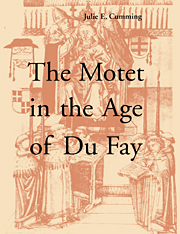Book contents
- Frontmatter
- Contents
- List of tables
- List of musical examples
- Acknowledgments
- Notes to the reader
- Introduction
- Part I Models and methods
- Part II Motets in the early fifteenth century: the case of Bologna Q15
- Part III Motets in the mid-fifteenth century: the case of the Trent Codices
- 8 Motets in the Trent Codices: establishing the boundaries
- 9 English and continental cantilena-style motets
- 10 Motets with a tenor cantus firmus c. 1430–1450
- 11 Freely composed four-voice writing in transition
- 12 The four-voice motet c. 1450–1475
- Conclusion
- Appendix: Widely disseminated motets
- Notes
- Bibliography of books and articles
- Modern editions of music
- Sources and sigla
- Notes on the index of works
- Abbreviations for subgenre identifications
- Index of works
- General index
11 - Freely composed four-voice writing in transition
Published online by Cambridge University Press: 22 September 2009
- Frontmatter
- Contents
- List of tables
- List of musical examples
- Acknowledgments
- Notes to the reader
- Introduction
- Part I Models and methods
- Part II Motets in the early fifteenth century: the case of Bologna Q15
- Part III Motets in the mid-fifteenth century: the case of the Trent Codices
- 8 Motets in the Trent Codices: establishing the boundaries
- 9 English and continental cantilena-style motets
- 10 Motets with a tenor cantus firmus c. 1430–1450
- 11 Freely composed four-voice writing in transition
- 12 The four-voice motet c. 1450–1475
- Conclusion
- Appendix: Widely disseminated motets
- Notes
- Bibliography of books and articles
- Modern editions of music
- Sources and sigla
- Notes on the index of works
- Abbreviations for subgenre identifications
- Index of works
- General index
Summary
In this chapter we will examine the four-voice motets without cantus firmus found in the earlier Trent Codices (TR+, 93, and 90), in Modena X.1.11, and in a few fragmentary sources. Most of these works are representatives of subgenres we have already examined (double-discantus motets, cut-circle motets, or English cantilenas); several are three-voice works to which a fourth voice was added later. The diverse approaches to four-voice texture found in these works are suggestive of a period of experimentation, and point to some of the ways in which the new four-voice textures of the second half of the century were created.
The end of the double-discantus texture
Two upper voices in the same range were standard for four-voice pieces on the Continent from c. 1415 to c. 1430; tenor and contratenor were also in the same range (with clefs a fifth lower than the upper parts). Virtually all of the four-voice motets in Q15, Du Fay's earlier isorhythmic motets, Brassart's four-voice motets, and many others use this double-discantus texture, which was a defining feature for continental motet-style compositions for three and four voices, both isorhythmic and free. Although it became less and less popular during the 1430s and 1440s, and essentially died out in the 1450s, the double-discantus subgenre continued to evolve during the period (see Table 11.1).
- Type
- Chapter
- Information
- The Motet in the Age of Du Fay , pp. 228 - 253Publisher: Cambridge University PressPrint publication year: 1999



